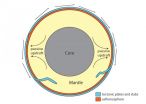(Press-News.org) The temperature of the seawater around Antarctica is rising according to new research from the University of East Anglia.
New research published today in the journal Science shows how shallow shelf seas of West Antarctica have warmed over the last 50 years.
The international research team say that this has accelerated the melting and sliding of glaciers in the area, and that there is no indication that this trend will reverse.
It also reveals that other Antarctic areas, which have not yet started to melt, could experience melting for the first time with consequences for sea-level rise.
Scientists looked at data from oceanographic records dating back to 1960, and found that temperatures in the West Antarctic Amundsen Sea and the Bellingshausen Sea have been rising.
Prof Karen Heywood, from UEA's Centre for Ocean and Atmospheric Sciences, said: "The Antarctic ice sheet is a giant water reservoir. The ice cap on the southern continent is on average 2,100 metres thick and contains about 70 percent of the world's fresh water. If this ice mass were to melt completely, it could raise the global sea level by 60 metres. That not going to happen, but it gives you an idea of how much water is stored there."
"Accelerated glacial melting in this area has been observed for some time, causing a major contribution to rising sea levels worldwide. We have shown how oceanographic changes over the last half century are likely to have caused this melting."
For example, the temperatures of the warmest waters near the sea bed in the Bellingshausen sea have warmed from about 0.8C in the 1970s to about 1.2C in the 2010s. "This might not sound like much", says the lead author of the study Sunke Schmidtko from GEOMAR in Germany, "but it is a large amount of extra heat available to melt the ice".
The water around Antarctica is also shown to be getting less salty, which is consistent with more ice melting from the Antarctic continent.
The research reveals that more warm water is being transported towards the ice. This accelerates the melting of glaciers from below and triggers the sliding of big glaciers towards the sea.
Antarctica is a cold island in the middle of a relatively warm ocean. The research has shown that the warm water in the deep ocean is getting shallower in many places around Antarctica. This means that it is easier for this warm water to get close to the ice shelves by reaching the shallow seas around Antarctica.
The southwestern Weddell Sea is a colder area where a large-scale melting of ice has not yet happened - and is one of the areas where this warm deep water is getting closer. Professor Heywood explains "Although many of the large ice shelves buttressing the Antarctic ice sheet are not yet melting, the source of warm water seems to be getting closer, so these ice shelves could begin to melt in future which is worrying in terms of global sea level rise."
There are other implications of higher seawater temperatures around Antarctica. Ocean biodiversity could also be affected - for example the spawning cycles of Antarctic krill, which play a key role in the Antarctic food chain, could change in warmer conditions.
INFORMATION:
The research team included scientists at UEA, the GEOMAR Helmholtz Centre for Ocean Research (Germany), the California Institute of Technology (US) and the University of Hokkaido (Japan). The research was funded by the UK's Natural Environment Research Council.
'Multidecadal warming of Antarctic waters' is published in Science on December 5, 2014.
CORVALLIS, Ore. - Scientists may have solved a long-standing enigma known as the African Humid Period - an intense increase in cumulative rainfall in parts of Africa that began after a long dry spell following the end of the last ice age and lasting nearly 10,000 years.
In a new study published this week in Science, an international research team linked the increase in rainfall in two regions of Africa thousands of years ago to an increase in greenhouse gas concentrations. The study was funded by the National Science Foundation and the U.S. Department of Energy.
The ...
A long-held assumption about the Earth is discussed in today's edition of Science, as Don L. Anderson, an emeritus professor with the Seismological Laboratory of the California Institute of Technology, and Scott King, a professor of geophysics in the College of Science at Virginia Tech, look at how a layer beneath the Earth's crust may be responsible for volcanic eruptions.
The discovery challenges conventional thought that volcanoes are caused when plates that make up the planet's crust shift and release heat.
Instead of coming from deep within the interior of the ...
VIDEO:
Vanderbilt biologist Kenneth Catania describes his discovery that the electroshock system used by the electric eel to detect and immobilize prey is uncannily similar to the Taser.
Click here for more information.
The electric eel - the scaleless Amazonian fish that can deliver an electrical jolt strong enough to knock down a full-grown horse - possesses an electroshock system uncannily similar to a Taser.
That is the conclusion of a nine-month study of the way in which ...
The "survival of the fittest" principle applies to cells in a tissue - rapidly growing and dividing cells are the fit ones. A relatively less fit cell, even if healthy and viable, will be eliminated by its more fit neighbors. Importantly, this selection mechanism is only activated when cells with varying levels of fitness are present in the same tissue. If a tissue only consists of less fit cells, then no so-called cell competition occurs. Molecular biologists from the University of Zurich and Columbia University are the first researchers to demonstrate in a study published ...
Since 2010, detections of Asian Carp environmental DNA or "eDNA" have warned scientists, policymakers, and the public that these high-flying invaders are knocking on the Great Lakes' door. Scientists capture tiny DNA-containing bits from water and use genetic analysis to determine if any Asian Carp DNA is present. New research published by Notre Dame scientists shows that the tools currently used for Asian Carp eDNA monitoring often fail to detect the fish. By comparison, the new eDNA methods described in this study capture and detect Asian Carp eDNA more effectively.
The ...
ITHACA, N.Y. - Among the billions and billions of stars in the sky, where should astronomers look for infant Earths where life might develop? New research from Cornell University's Institute for Pale Blue Dots shows where - and when - infant Earths are most likely to be found. The paper by research associate Ramses M. Ramirez and director Lisa Kaltenegger, "The Habitable Zones of Pre-Main-Sequence Stars" will be published in the Jan. 1, 2015, issue of Astrophysical Journal Letters.
Images and study: https://cornell.box.com/infantearths
"The search for new, habitable ...
For nearly 40 years, one of the cornerstones of the study of adaptation has been the examination of "whole-organism performance capacities"--essentially, measures of the dynamic things animals do: how fast they can run; how hard they can bite; how far, fast, and high they can jump; and so on. Together, these functional attributes determine the performance of a species' ecology: the types of food one can eat; the ability to capture or locate prey; the ability to avoid predation; the ability of males to intimidate or, in some cases, prevent rival males from invading a territory; ...
Insects can transmit viral diseases to humans. Therefore, understanding how insects cope with viral infection, and what immune mechanisms are triggered, can be important to stop diseases transmission. In a study published in this week's issue of the scientific journal PLOS Pathogens*, researchers from the Instituto Gulbenkian de Ciencia (IGC; Portugal) now show that the entry route of the virus changes how the insect host responds to it. Using the fruit flies as a model of study, they discovered an immune mechanism that is specifically effective when flies are infected ...
BOULDER - New research demonstrates for the first time that an increase in greenhouse gas concentrations thousands of years ago was a key factor in causing substantially more rainfall in two major regions of Africa. The finding provides new evidence that the current increase in greenhouse gases will have an important impact on Africa's future climate.
The study, led by the National Center for Atmospheric Research (NCAR), is being published this week in Science.
"The future impact of greenhouse gases on rainfall in Africa is a critical socioeconomic issue," said NCAR ...
WASHINGTON - Children in emergency departments can safely be treated for pain from limb injuries using intranasal ketamine, a drug more typically used for sedation, according to the results of the first randomized, controlled trial comparing intranasal analgesics in children in the emergency department. The study was published online last month in Annals of Emergency Medicine ("The PICHFORK (Pain in Children Fentanyl OR Ketamine) Trial: A Randomized Controlled Trial Comparing Intranasal Ketamine and Fentanyl for the Relief of Moderate to Severe Pain in Children with Limb ...


